8. Solar/Battery and EV¶
In 2022 during the energy issues, our supplier went bust and we were dragged over to British Gas. Our costs shot up to around £ 500 a month just to run the house.
We had 2 ICE (Internal Combustion Engine) cars, VW Polo and a VW Tiguan allspace, costing around £ 400 each month for fuel.
Time to see what optimisation I can do.
8.1. The Plan¶
Take advantage of time based energy pricing, using only the cheap rates which at the time was 10p/kWh for night and 30p/kWh for daytime. This pricing was around the same for all suppliers.
If I can just use the night rates then I would drop my monthly costing from £ 500 to £ 167. The only way to achieve that is to have battery storage for the house, charge the battery on the night rate and then run the house on the battery alone.
My house uses around 30kWh over a 24 hour period. During the night rates I obviously don’t need to run the battery, so I can reduce that amount down to around 23kWh. Most battery systems seem to come in 14kWh packs therefore I’ll need two giving 28kWh.
When the oven or other high draw appliance is running it’s going to pull a lot of current. Most inverters will max out at 5kW, which is not enough to handle that load, this will mean we’ll briefly have to pull from the grid.
I therefore need 28kWh battery storage and be able supply 10kW of power. I would also like to seamlessly handle power cuts and keep running the complete house, I don’t want to have to choose which circuits to keep running.
At the time most battery/solar systems shutdown when they detect a power cut so as not to energise the grid which could cause a safety issue.
While space wasn’t a key selection criterial I did notice that some of the battery systems have a large footprint when you start looking at higher capacity.
If I put solar panels on the house as well then anything they generate can run the house and recharge the battery during the day, which will mean less import and thus reducing the monthly costing further. By adding solar to the order, we can deduct the VAT from the order.
We have 2 just off south facing pitched roofs. We can put 8 on the upper roof and 3 on the lower one (Well technically I can put 4 however there is no side access to garden so needed to keep some space), this gives a total of 11 panels.
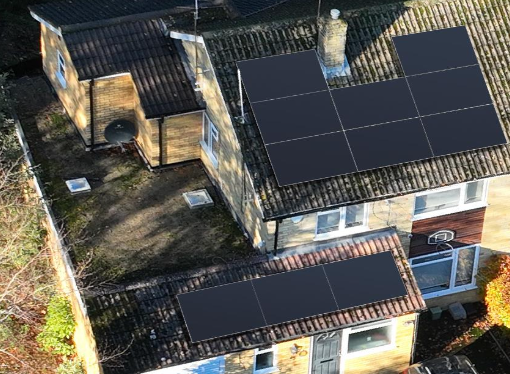
We’re going to replace the two ICE cars with EVs, with off road parking it makes sense to have two charging points. We can then charge two cars over night on the low rate.
8.2. Before the Switch¶
We had the good old bakerlite meter and a metal fusebox with 1 free slot. We need at least 5 slots, 1 for solar, 2 for chargers, and 2 for batteries. I also had to confirm that the house fuse (The big chunky black thing which is connected before the meter) was big enough. Some houses were fitted with 50Amp fuses. We however had the more common 100Amp.
With 100Amp Fuse and the grid voltage as 240Volts we can work out the maximum I can pull from the grid.

The maximum I can pull is 24kW, as I really don’t want to blow the fuse or melt cables we’ll bring that down to 20kW as a working maximum, that gives a nice buffer.
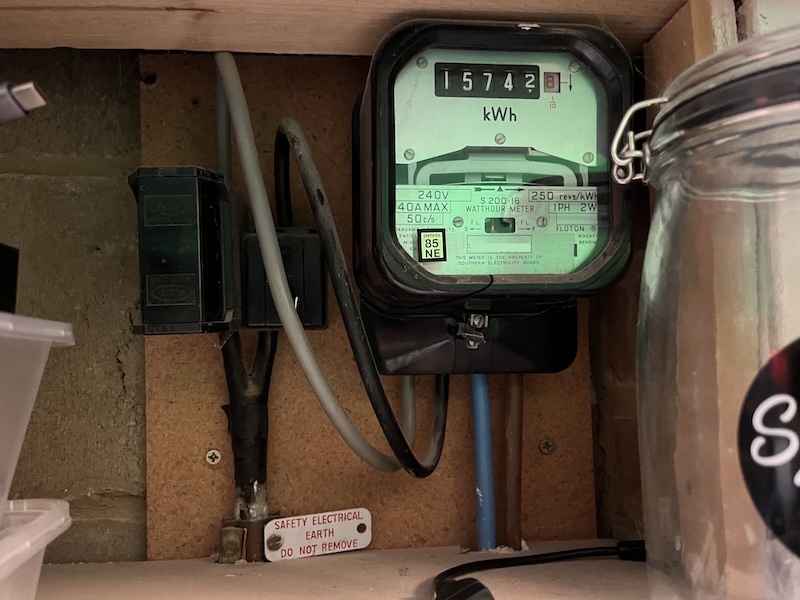
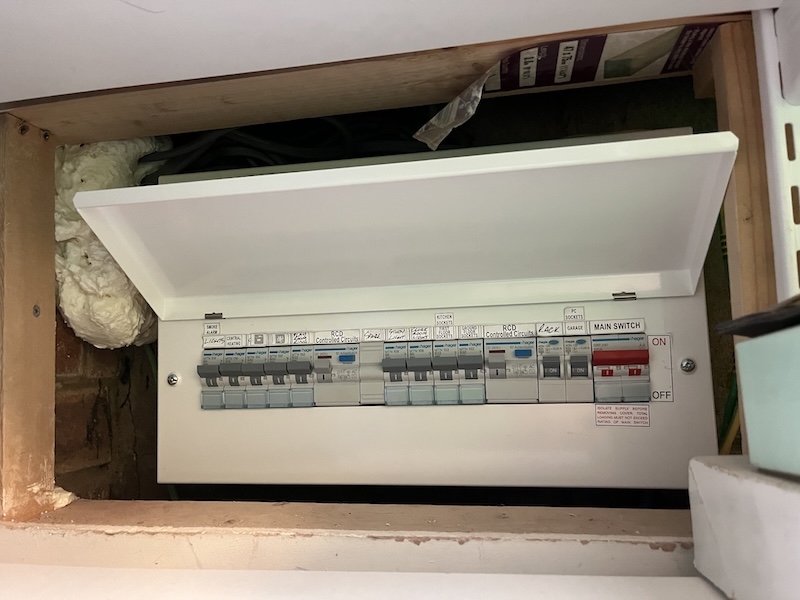
8.3. Installing¶
The first thing to arrange was to have the meter switched to a smart meter so I could take advantage of time based metering. As others have suggested it would be quicker to have the incumbent supplier perform the swap so we booked British Gas to replace the gas and electric meters.
I went on British Gas website and booked a date which was 2 weeks away. However on the day before they contacted me to cancel the appointment. I had to book again which was another 2 weeks away. They swapped the electric meter (took a little time to complete 4-5 hours). They then swapped the gas meter (very quick less than 1 hour), however it turns out they swapped it for a known broken (wouldn’t pair up with electric meter) one (not sure why they did that).
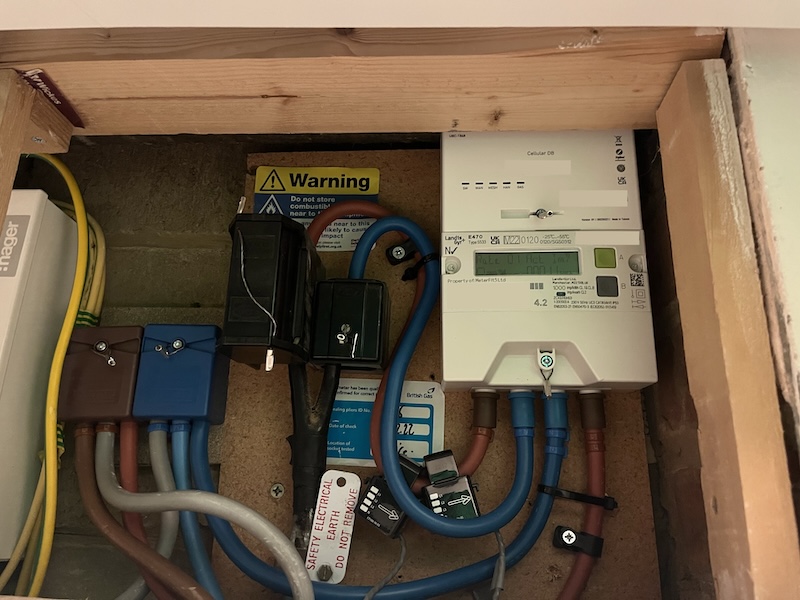
Now we have a smart meter I started the transfer of my billing from British Gas over to  Octopus Energy. We selected Octopus as they have a great customer support track record and offer the lowest off-peak rates. With an EV I can get the price down to 7.5p/kWh.
Octopus Energy. We selected Octopus as they have a great customer support track record and offer the lowest off-peak rates. With an EV I can get the price down to 7.5p/kWh.
The transfer only took a few days to complete. Octopus first transfer onto their standard rate. Once they confirm they are receiving smart reading usually a week later, you can switch to the correct tariff.
We selected Kimble Solar to perform the installation as their price was competitive, they are very local within walking distance. They only use their own staff (no sub contracting). The only external staff were the scaffold riggers.
Kimble recommended the solar panels, inverter and Zappi chargers. They also suggested the GiveEnergy battery system, however at the time it did not support larger batteries and you couldn’t have multiple units together.
8.3.1. Zappi¶
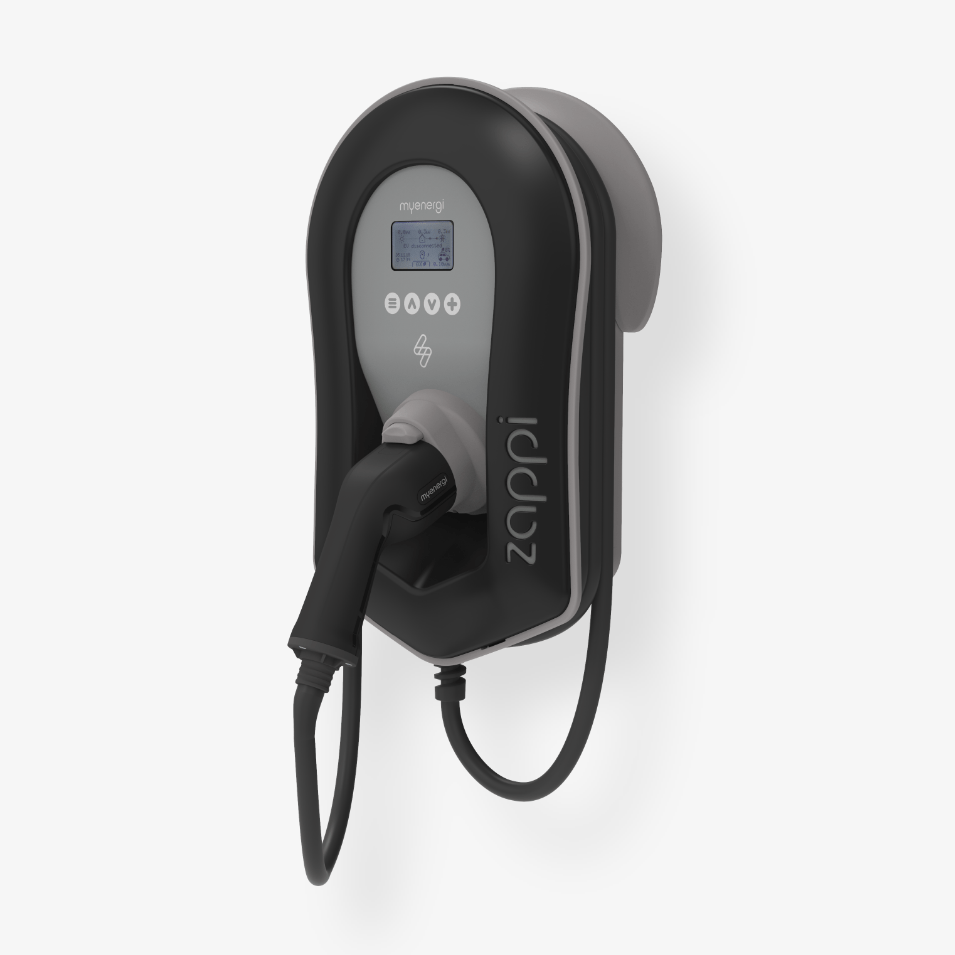

The Zappi charger by Myenergi retails for around £ 800, so not cheap but looking at all it’s functionality including time-based control, and integration with Intelligent Octopus makes it a really good choice.
I only have a single phase grid supply. With the Zappi I can charge the car at 7.5kWh. The ID.4 has a 88kWh battery, assuming I need to fill it from empty to full  hours. However I normally only charge to 80% (Which is good practice, unless you are doing a long trip) which brings the necessary amount to 70kWh, that’s now only 9 hours to charge from empty. With Octopus I get 6 hours of cheap rate (
hours. However I normally only charge to 80% (Which is good practice, unless you are doing a long trip) which brings the necessary amount to 70kWh, that’s now only 9 hours to charge from empty. With Octopus I get 6 hours of cheap rate ( kWh), not quite enough to do back to back long trips, however Intelegent Octopus often also provide additional charging sessions so it’s possible with those as well I can get the car back to it’s 80% level.
kWh), not quite enough to do back to back long trips, however Intelegent Octopus often also provide additional charging sessions so it’s possible with those as well I can get the car back to it’s 80% level.
I also picked the Zappi with it’s own cable, I would rather keep the cars own charging cable wrapped up and in the car. Cable on the Zappi is very long and can easily reach anywhere on my driveway, I do however tend to back the cars onto the driveway so the possible trip hazard and the like is minimised.
I have pin code locked the Zappis menus, but allow connecting and charging without any interaction.
8.3.2. Tesla Powerwall¶
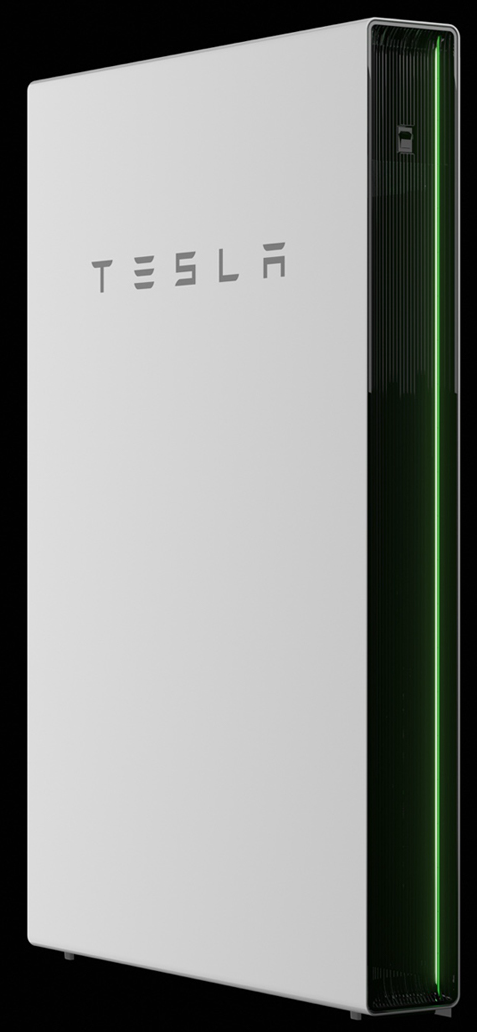
With some additional research on battery storage and with all my requirements above the only choice was the Tesla Powerwall, not cheap and somewhat hard to source at the time. I ended up waiting around 6months for two Powerwall 2 units.
The Tesla Powerwall system scales laterally, I can plugin in more and more batteries to meet demand (up to 6). Each battery is AC coupled and has it’s own 5kW Inverter. They have a control cable linking them together and to the gateway. They then act as a single unit. Charging and discharging sharing the load. With two this gives me the 28kWh that I require and also up to 10kW for both charging and discharging.
Being able to charge at 10kW is critical so I can be sure to complete a charge within the low night rate time frame. in fact the Powerwalls will charge in just under 3 hours.

That’s assuming the wall is completely flat. The powerwall doesn’t go flat, they discharge down to 5%, unless there’s a power cut. You can also set this backup threshold, depending on how often you get powercuts and how long they last for. Here we typically get brown outs (volt drops for a few seconds), and any powercuts only last less than a minute. We have had one power cut which lasted 1.5hours but that was really an exception. So I’m happy to allow the wall to discharge down to 5%. This also means I can push any stored battery power back to the grid just before starting to recharge.
8.3.3. Solar panels¶
We have 11 panels and a 3.5kW Inverter. Given the position and shading as the sun moves around we have a maximum generation of 30kWh which I have achieved a few times last summer. My peak window for generation is between 0800 and 1500. Outside this I’m still generating but the rate is down to a few hundred watts. The house takes 900Wh as a base load.
Over the year 2023 the solar panels generated 4MWh. Which is not a massive amount, but it all helps reduce my bills. At first I was using the solar excess to charge the cars, however now I’ve switched to fixed export I’m preferring to export giving a 15p per kWh and charging the cars at night at the 7.5p rate.
8.3.4. Installed products¶
11x Black Peal Solar panels
Bird protection
11x Tigo Solar Optimisers
1x Growatt (MIN 3600TL-X) Solar inverter
1x Additional fuse box
2x Myenergi Zappi Smart EV Chargers
2x Tesla Powerwalls 2
1x Tesla Gateway
1x Earth spike
2x DC Isolation switches
4x AC Isolation switches
1x Solar generation meter
8.4. Cars¶
My Wife has been driving a VW polo and wanted a car around the same size. We test drove a VW ID.3 which we ended up buying.
I was driving VW Tiguan Allspace which I had bought in 2018. When I looked to exchange it I only needed to add £ 2k to the get the VW ID.4 so that was an easy choice.
We decided to keep the polo for the children to drive.
We mainly drive short journeys so can charge at home rather than public charging. I have driven to Birmingham and back on a single charge without issue. When we do need to charge we try to minimise the cost by returning home on low battery.
8.5. Electroverse¶
We have signed up to the Electoverse, which also offers 8% discount on charging through multiple charging providers. While we’ve not yet used this it should help mitigate when we are doing long distant trips. The billing is charged back to my Octopus bill.
8.6. Home Assistant¶
During this time I was put on to Home Assistant as a tool to help with integrating all these things into a single interface. In fact it’s far more than that.
First you need to run a little system to run the HA software. This could be a raspberry PI, costing around £ 50 (Pi 4 or 5 with case and power supply). I have a Proxmox cluster running here so I quickly setup a VM to run it. Once the system is setup it will start to discover things on the network, you can also install additional integration modules to support even more things.
For example I have Tractive GPS tracking units for the cats. I installed the integration and can see that status of the trackers mainly used to monitor the battery status.

As you can see I’ve linked many of the smart things in my house to HA, I can then quickly see their status but also automate their operation. For energy side, I can monitor the grid usage, solar panels, battery, Zappi chargers, and the EV Cars status, as well as the house usage.
You can create as many views as you like, each view can display information but also provide interaction widgets to control. Below is my overview page, from here I can see powerflow, charge status of my powerwalls and cars. I can also set the cars charge targets and even turn on their climate control (really handy during cold days).
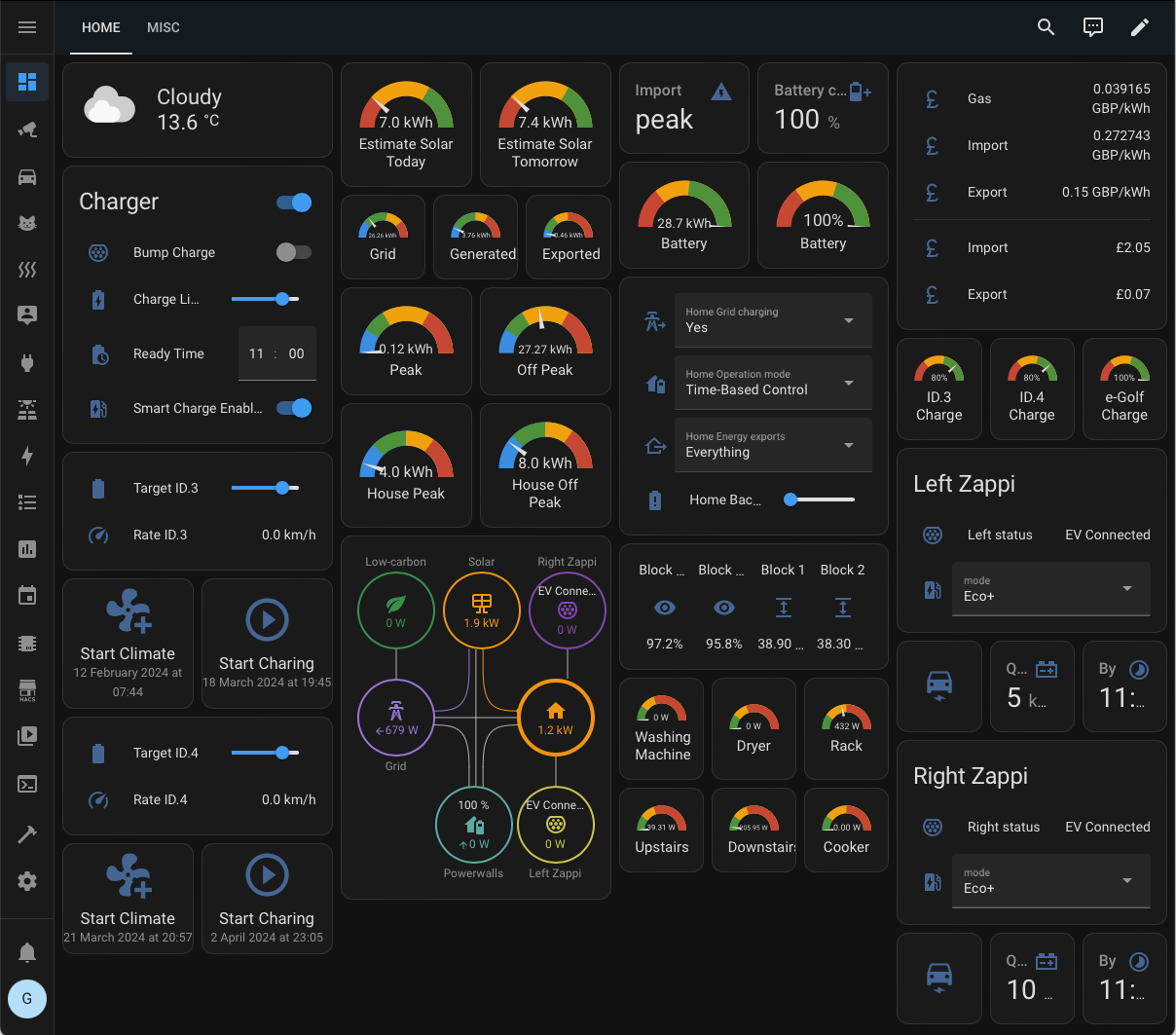
8.7. Octopus tariff¶
Using just one of the Zappi’s (At the time of writing they only support one). I signed up to Intelegent Octopus, which offers 7.5p over night from 2330 - 0530 each and everyday. I can use the power for whatever I want. So I have the other Zappi set on a schedule to charge between those times, and the Tesla Powerwalls to do likewise.
Now with IO they are controlling one of the Zappi’s and when a car is plugged in they create a charging schedule, you define how much charge your car needs as a percentage and when you need the car by. As I work from home, I have my ready by time set to the maximum of 1100. When the grid is green, Octopus can add extra charging sessions outside of the 2330-0530 timeslots and give you cheap power then as well. So I also have the powerwall via HA look for these extra slots and recharge it’s self if necessary but otherwise run the house of low cost grid power.
Octopus also changed their export tariff to allow IO customers to export to the grid. They offer two choices, Agile and fixed. When I first signed up I selected Agile, where the price changes through out the day so you have to pick the best time (usually between 1600-1900) to export. I was happy doing this however, the prices were usually not to far from the fixed price so after a few months doing this I decided to change to fixed. With fixed I get 15p/kWh regardless of when I export. This for me turns out to be a much better option as I can easily export extra solar during the day and still dump the battery last thing at night, thus maximising my export capability.
Octopus offer Energy saving schemes (Government backed), at peak requirement times they can request you use less power and they will pay you for this. They will even pay for power exported during this time. Moving my export outside of the likely saving sessions times (1600 - 1900) means I should also be able to be more effective.
8.8. Octotrack¶
I wrote a simple web application which makes use of the Octopus API to pull my real billable usage data as well as tariff information and provide some charts to show how I’m doing. Each day I can pull the previous days usage in half hour blocks. My billing date is 21st of the month. So the chart below is showing latest unbilled readings.
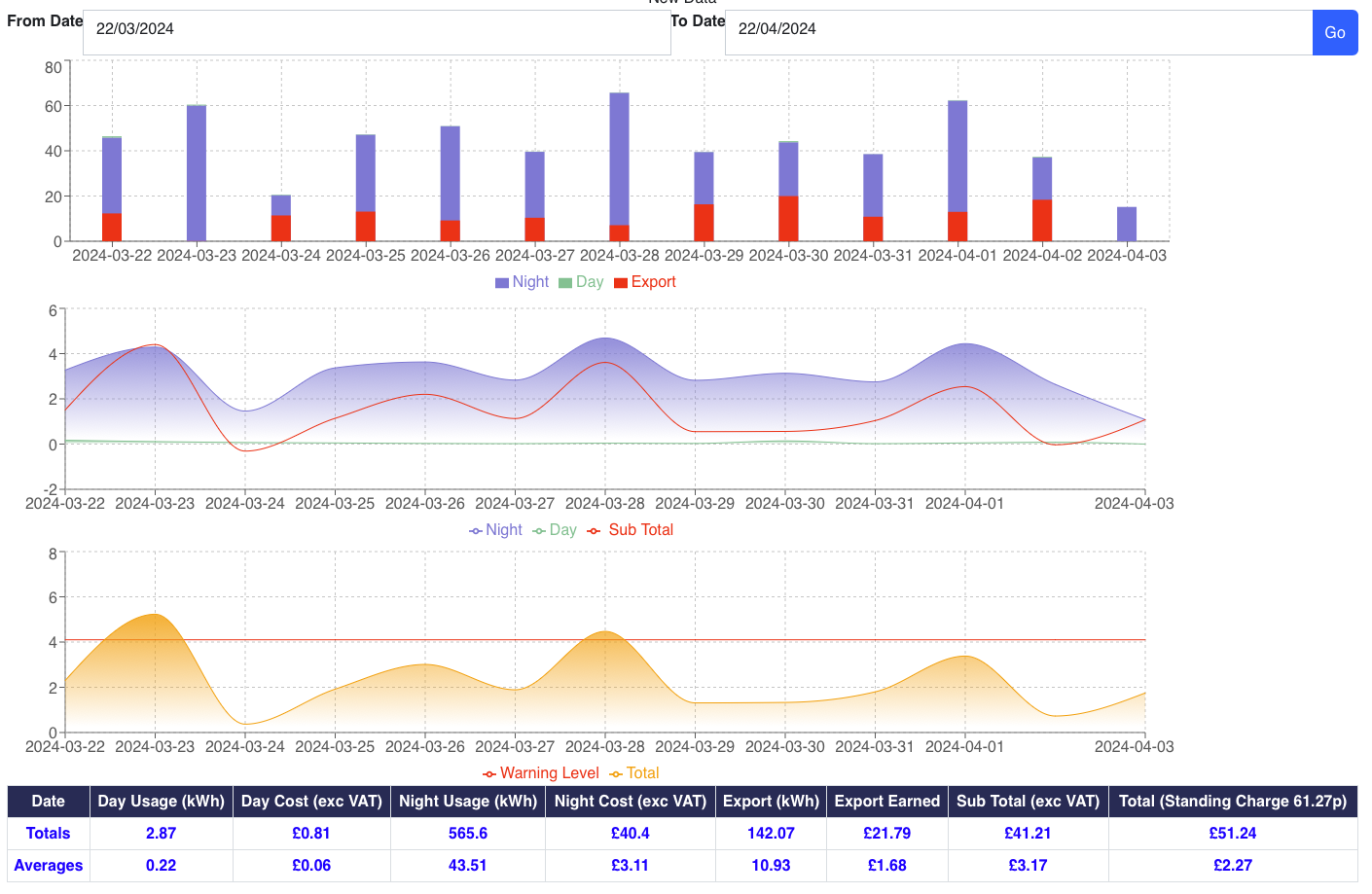
As you can see I’m tracking my day and night rates as well as export. We’re just coming into good solar time so my daily average cost is currently £ 2.27. That’s to charge the cars and run the house. I fully expect that to drop further as the summer progresses.
8.9. Looking at the Numbers¶
Here’s my bill from last month, you can see I used 1946kWh of 7.5p power and only 3.2kWh of the higher rate. This is perfect, just what I want to see. This then gives me a price per kWh of 7.18p + VAT.
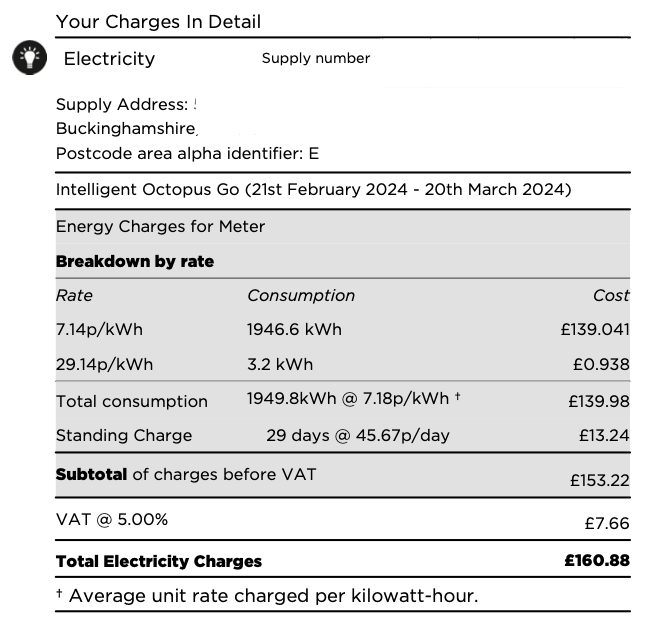
Next we add in the export which for this bill is on Agile.
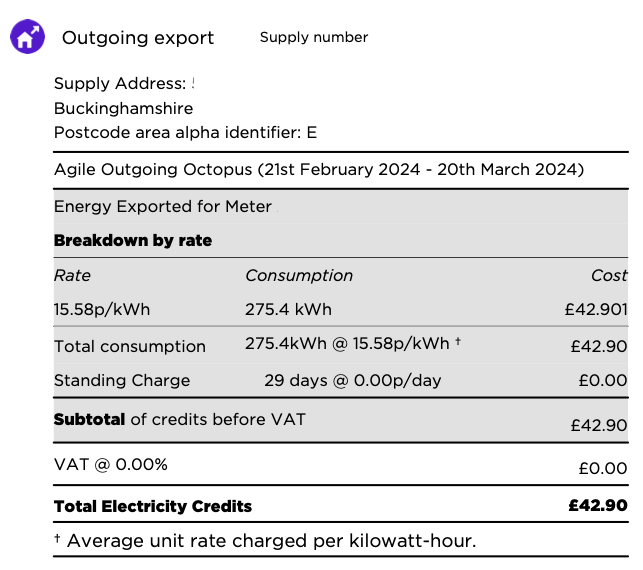
As you can see on Agile my sale price was 15.58p/kWh, so not much above the fixed rate of 15p. Due to the limited window of time for export I was only able to export 275.4kWh which isn’t very much but gives me £ 42.90.

That reduces my cost p/kWh to 4.9p
If we take all my usage from 1st November 2023 until 1st April 2024, 5 months. Total of £ 550 for 9,597kWh.
To make things a little simpler we’ll add the standing charge over the year  = £219
= £219
8.9.1. Staying on British Gas and ICE cars¶
If I had stayed on British Gas rate which is 30p  = £6,910.
Adding on the 5% VAT
= £6,910.
Adding on the 5% VAT  = £7,255
= £7,255
Lets remove the cost of charging the EV cars, approx 7200kWh  = £4,750.
= £4,750.
Adding on the 5% VAT  = £4,988
= £4,988
Fuel costs of £400 a month  = £4,800
= £4,800

Staying on British Gas and ICE cars would cost me £10,007 a year.
8.9.2. Making all the improvements¶
Yearly billing  = £1,320.
= £1,320.
Adding on the 5% VAT  = £1,386
= £1,386

This gives me a saving of  = £8,403 per year.
= £8,403 per year.
This will give me a buy back on all the equipment within 4 years!
8.10. So was it all worth it?¶
Without a doubt YES!
Reducing my bills by £8400 a year is fantastic, after 4 years I’ll have covered the cost of installation, well within any warranty or life expectancy of the parts.
We never have to pay for fuel at the pumps and seeing those prices steadily going up. We just plug the cars in when we get home and it all happens over night while we’re in bed.
We are also doing our bit for the environment.
